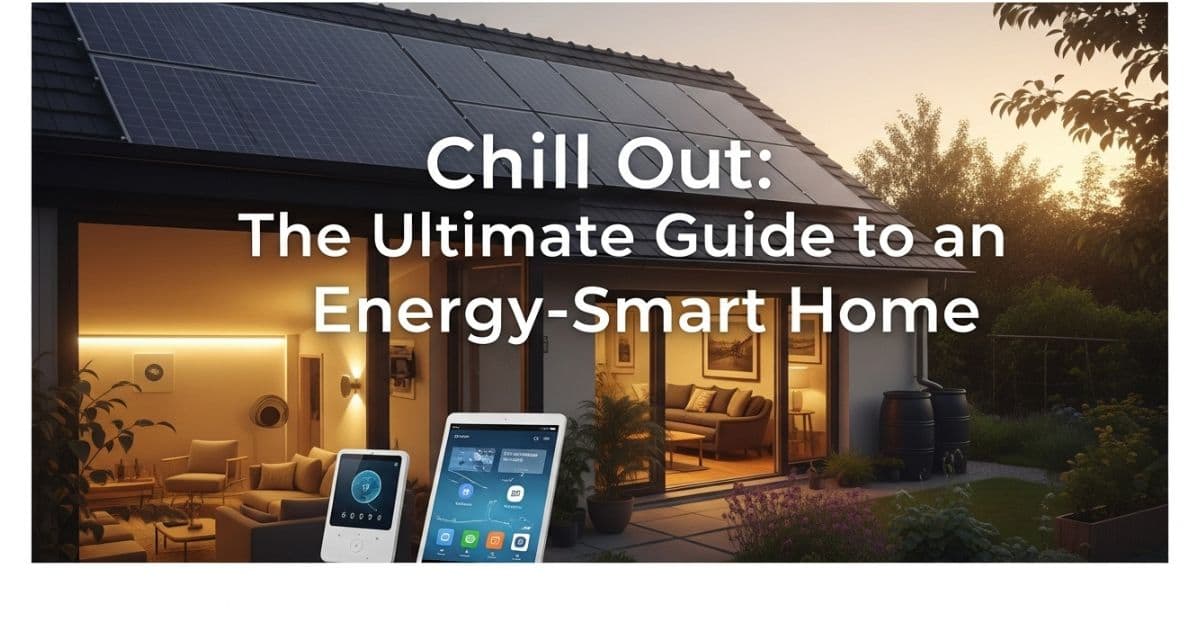Creating an energy-smart home isn’t just about saving money on your utility bills—it’s about contributing to a greener planet, improving your home’s efficiency, and enhancing comfort year-round. This comprehensive guide explores the practical, cost-effective, and impactful steps you can take to transform your space into an energy-efficient sanctuary.
Contents
- 1 Why Energy Efficiency Matters
- 2 Conducting a Thorough Energy Audit
- 3 Insulation and Air Sealing: The Foundation of Efficiency
- 4 Energy-Efficient Windows and Doors
- 5 Smart Thermostats: A Smarter Way to Control Temperature
- 6 Lighting the Smart Way: LED and Automation
- 7 Upgrade to Energy-Efficient Appliances
- 8 Optimize Your HVAC System
- 9 Water Heating: Tips for Maximum Efficiency
- 10 Embrace Renewable Energy Options
- 11 Passive Solar Design for New Homes
- 12 Energy-Saving Landscaping
- 13 Smart Power Management
- 14 Embrace Low-Energy Habits
- 15 Integrating a Home Energy Management System (HEMS)
- 16 Creating a Smart Home Ecosystem
- 17 Financial Incentives and Rebates
- 18 Long-Term Maintenance Tips for Efficiency
- 19 Actionable FAQs: Energy-Smart Home Insights
- 19.1 What is the most effective way to start creating an energy-smart home?
- 19.2 How much can I save by making my home energy-smart?
- 19.3 Are smart thermostats really worth it?
- 19.4 How do I know if my windows need upgrading?
- 19.5 Can solar panels really eliminate my energy bill?
- 19.6 What’s the return on investment (ROI) for energy-efficient appliances?
- 19.7 Is a programmable power strip really necessary?
- 19.8 How often should I maintain my HVAC system?
- 19.9 What’s the cheapest energy-smart home upgrade I can make today?
- 19.10 Can landscaping really make a difference in energy efficiency?
- 19.11 What is the benefit of passive solar design?
- 19.12 Do smart appliances significantly cut energy use?
- 19.13 How does a HEMS differ from a smart thermostat?
- 20 Final Thoughts: Chill Out and Power Smart
Why Energy Efficiency Matters
Energy efficiency isn’t a buzzword—it’s a lifestyle choice that offers substantial benefits:
- Reduced energy bills
- Lower carbon footprint
- Enhanced indoor comfort
- Increased property value
- Extended appliance and system life
By adopting smarter energy practices, you also align yourself with sustainability goals and contribute to combating climate change.
Conducting a Thorough Energy Audit
Before diving into upgrades, get a professional or DIY home energy audit. This assessment will help you:
- Identify energy leaks
- Understand where energy is being wasted
- Prioritize upgrades for the best ROI
DIY Energy Audit Tools
- Infrared thermometers
- Smart plugs and energy monitors
- Thermal leak detectors
- Draft detectors and smoke pencils
Professional Energy Audits
Numerous utility companies provide energy audits for free or at a reduced cost. A certified energy auditor will:
- Use blower door tests
- Inspect insulation and ductwork
- Analyze utility bills
- Provide a customized efficiency plan
Insulation and Air Sealing: The Foundation of Efficiency
Proper insulation and sealing are your first line of defence against energy waste.
Key Areas to Insulate:
- Attics and crawlspaces
- Exterior walls
- Floors above unheated garages
- Basements and foundation walls
Sealing Techniques:
- Weatherstripping doors and windows
- Caulking around window frames, baseboards, and pipes
- Foam sealing electrical outlets and wall penetrations
Energy-Efficient Windows and Doors
Upgrading your windows and doors can dramatically impact your home’s energy performance.
Window Features to Look For:
- Double or triple-pane glass
- Low-E (low-emissivity) coatings
- Argon or krypton gas fills
- Thermal breaks in window frames
Door Upgrades:
- Install insulated exterior doors
- Add storm doors
- Use door sweeps to block drafts
Smart Thermostats: A Smarter Way to Control Temperature
A smart thermostat is a must-have for an energy-smart home.
Benefits of Smart Thermostats:
- Learn your habits and adjust automatically
- Provide detailed energy usage reports
- Offer remote control via smartphone
- Integrate with home automation systems
Popular Models:
- Google Nest
- Ecobee SmartThermostat
- Honeywell Home T9
Lighting the Smart Way: LED and Automation
Lighting can be both efficient and beautiful.
Why Choose LED:
- Use 75% less energy
- Last up to 25 times longer
- Produce less heat
Smart Lighting Systems:
- Voice control with Alexa or Google Assistant
- Automated dimming and scheduling
- Motion sensors and daylight-responsive lighting
Upgrade to Energy-Efficient Appliances
Old appliances are major energy hogs. Upgrading helps reduce consumption significantly.
ENERGY STAR Appliances to Prioritize:
- Refrigerator: Choose inverter models
- Washer/Dryer: Opt for front-loading and moisture sensors
- Dishwasher: Look for low-water-use cycles
- Oven and Range: Use induction cooking
Smart Appliances
- Provide remote diagnostics
- Offer real-time energy tracking
- Integrate with smart home ecosystems
Optimize Your HVAC System
Heating and cooling make up a large portion of energy usage.
Tips for HVAC Efficiency:
- Schedule annual tune-ups
- Replace filters regularly
- Upgrade to high SEER-rated systems
- Use ceiling fans to assist airflow
Zoning Systems:
- Tailor temperature control room by room
- Improve comfort and efficiency
- Reduce energy waste in unused areas
Water Heating: Tips for Maximum Efficiency
Water heaters often run silently in the background—until your energy bill arrives.
Energy-Saving Tactics:
- Lower thermostat to 120°F
- Install an insulating blanket
- Upgrade to a tankless water heater
- Use solar thermal water heaters if available
Embrace Renewable Energy Options
Solar Panels
- Drastically reduce utility bills
- Federal and state tax credits available
- Consider solar batteries for energy storage
Wind Turbines
- Suitable for rural or large properties
- Can supplement solar energy
Geothermal Heating and Cooling
- Most efficient HVAC option
- Uses the earth’s stable temperature
- High upfront cost but excellent ROI
Passive Solar Design for New Homes
If building new or renovating, design can play a major role in energy efficiency.
Design Features:
- South-facing windows
- Thermal mass flooring (concrete or stone)
- Overhangs for seasonal sun control
- Cross-ventilation for cooling
Energy-Saving Landscaping
Use your yard to naturally regulate your home’s temperature.
Landscaping Ideas:
- Plant shade trees near windows
- Use vines on trellises to block sun
- Create windbreaks with evergreens
- Use ground cover to reduce heat absorption
Smart Power Management
Avoid phantom energy loss with smart tech.
Tools:
- Smart power strips
- Energy-monitoring plugs
- Timers and occupancy sensors
Embrace Low-Energy Habits
Everyday Changes:
- Air-dry dishes and laundry
- Use pressure cookers or microwaves instead of ovens
- Consolidate electronics and unplug when not in use
- Switch to cold water laundry cycles
READ MORE: Ultimate Guide to Solar Energy Storage for a Greener Planet
Integrating a Home Energy Management System (HEMS)
HEMS offers a centralized way to track and optimize usage.
Features:
- Real-time energy monitoring
- Appliance usage tracking
- Personalized energy recommendations
Creating a Smart Home Ecosystem
A fully integrated home can streamline your energy-saving efforts.
Integration Examples:
- Thermostat linked with motion sensors
- Lighting controlled by voice or app
- Appliances managed from your phone
Financial Incentives and Rebates
Types of Incentives:
- Federal tax credits (e.g., for solar panels)
- State/local utility rebates
- Energy-efficient mortgage programs
Where to Look:
- Database of State Incentives for Efficiency & Renewables, or DSIRE
- ENERGY STAR Rebate Finder
Long-Term Maintenance Tips for Efficiency
Maintenance ensures that your upgrades deliver results for years.
To-Do List:
- Schedule HVAC and water heater maintenance
- Clean refrigerator coils
- Inspect insulation annually
- Update weatherstripping
Actionable FAQs: Energy-Smart Home Insights
What is the most effective way to start creating an energy-smart home?
Start with an energy audit. Whether professional or DIY, it helps you identify the most critical areas for improvement and plan cost-effective upgrades.
How much can I save by making my home energy-smart?
Depending on your upgrades, you could save 10% to 30% on energy bills annually. Simple changes like LED lighting and smart thermostats provide quick returns.
Are smart thermostats really worth it?
Yes, smart thermostats adapt to your routine and reduce unnecessary heating or cooling, leading to substantial savings and increased comfort.
How do I know if my windows need upgrading?
If your windows are single-pane, drafty, or condensation-prone, consider upgrading to double-pane or ENERGY STAR-rated windows.
Can solar panels really eliminate my energy bill?
In many regions, yes. With the right size system and net metering, solar panels can cover all your electricity needs, sometimes even generating excess.
What’s the return on investment (ROI) for energy-efficient appliances?
While upfront costs are higher, ENERGY STAR appliances pay for themselves within 3–5 years through energy savings.
Is a programmable power strip really necessary?
Yes, especially for home offices and entertainment centers. They eliminate phantom energy use from devices left in standby mode.
How often should I maintain my HVAC system?
At least once a year. Regular maintenance improves efficiency, extends lifespan, and keeps your indoor air healthy.
What’s the cheapest energy-smart home upgrade I can make today?
Switching to LED lighting is the most affordable and impactful first step.
Can landscaping really make a difference in energy efficiency?
Absolutely. Shade trees and windbreaks reduce heating and cooling demands, enhancing comfort and saving money.
What is the benefit of passive solar design?
Passive solar design uses your home’s orientation, materials, and layout to naturally regulate temperature, reducing heating and cooling loads.
Do smart appliances significantly cut energy use?
Yes. Many offer features like delay start during off-peak hours and energy consumption data to help manage use effectively.
How does a HEMS differ from a smart thermostat?
A Home Energy Management System monitors total energy use and integrates multiple devices, while a smart thermostat focuses mainly on HVAC control.
Final Thoughts: Chill Out and Power Smart
Creating an energy-smart home is a rewarding journey. While some improvements require investment, many are affordable, actionable, and yield immediate results. From adjusting your thermostat to harnessing the power of the sun, every step you take contributes to a more sustainable lifestyle and a cooler, more cost-efficient home.
The modern energy-smart home is not just about devices—it’s about awareness, intention, and consistent habits. With the right strategies, you can reduce costs, enhance comfort, and protect the planet, one upgrade at a time.
So, chill out and let your home work smarter—not harder—for you.

Harper Leigh is a dedicated writer at hsnime.co.uk, where she crafts engaging and insightful content on a wide range of topics. With a passion for storytelling and connecting with readers, Harper aims to inspire, inform, and entertain through her articles.






